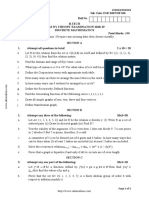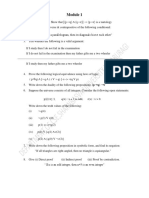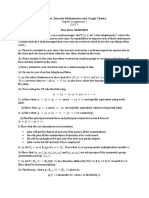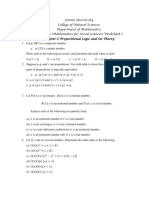0% found this document useful (0 votes)
8 views2 pagesDMS Assignment 1
This document is an assignment for a Discrete Mathematical Structure course, covering various topics such as truth values of propositions, laws of logic, proofs by induction, combinatorial problems, and relations. It includes specific problems to solve, such as proving tautologies, negating propositions, and finding permutations and combinations. The assignment also requires students to define key concepts and test the validity of logical arguments.
Uploaded by
yashdande219Copyright
© © All Rights Reserved
We take content rights seriously. If you suspect this is your content, claim it here.
Available Formats
Download as DOCX, PDF, TXT or read online on Scribd
0% found this document useful (0 votes)
8 views2 pagesDMS Assignment 1
This document is an assignment for a Discrete Mathematical Structure course, covering various topics such as truth values of propositions, laws of logic, proofs by induction, combinatorial problems, and relations. It includes specific problems to solve, such as proving tautologies, negating propositions, and finding permutations and combinations. The assignment also requires students to define key concepts and test the validity of logical arguments.
Uploaded by
yashdande219Copyright
© © All Rights Reserved
We take content rights seriously. If you suspect this is your content, claim it here.
Available Formats
Download as DOCX, PDF, TXT or read online on Scribd
/ 2
























































































